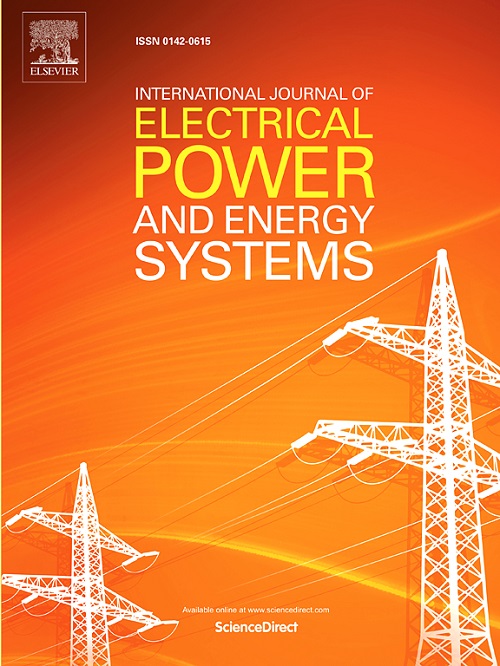为频率调节实现可再生能源的非虚拟惯性控制:建模、分析和新控制方案
IF 5
2区 工程技术
Q1 ENGINEERING, ELECTRICAL & ELECTRONIC
International Journal of Electrical Power & Energy Systems
Pub Date : 2024-10-17
DOI:10.1016/j.ijepes.2024.110314
引用次数: 0
摘要
目前,当可再生能源发电参与频率调节时,传统的控制方法是通过虚拟惯性控制来模拟同步发电机。然而,虚拟惯性有时间延迟,因此本质上是一种快速功率响应。同时,虚拟惯性控制很可能会受到频率波动的影响,因为它响应的是频率的导数。因此,在参与频率调节时,可再生能源的非虚拟惯性控制值得探讨。为此,本研究提出了一种用于可再生能源频率调节的新型两段式下垂控制方案。首先,建立包含时延虚拟惯性的扩展系统频率调节(SFR)模型,并基于 Routh 近似方法进行阶次递减分析求解。之后,根据解析解,时间延迟会影响可再生能源的频率响应。通过分析还可以证明,在相同的频率偏差下,非虚拟惯性控制(如唯一垂度控制)可以取代虚拟惯性控制。不过,频率调节可能需要更多能量。此外,本文还提出了一种新型的两段式下垂控制,并采用脉冲函数平衡原理和分部积分算法对微分方程的初始条件进行分析,以证明其替代虚拟惯性的能力。根据解析表达式,可以分析证明在相同频率调节能量下,可以获得较低的频率偏差。据此,提出了一种两段下垂控制的参数设置方法。最后,利用两区系统频率响应模型验证了所提方法的有效性,结果表明该方法可用于替代虚拟惯性,并具有更好的性能。本文章由计算机程序翻译,如有差异,请以英文原文为准。
Towards non-virtual inertia control of renewable energy for frequency regulation: Modeling, analysis and new control scheme
Currently, when renewable generation participates in frequency regulation, the traditional control method is to emulate synchronous generators through virtual inertia control. However, virtual inertia has a time delay, so essentially, it is a fast power response. Meanwhile, virtual inertia control is likely to be affected by frequency fluctuation since it responds to the derivative of frequency. Hence, it’s worth exploring non-virtual inertia control for renewable energy when participating in frequency regulation. For this reason, a novel two-segment droop control scheme for renewable energy frequency regulation is proposed in this research. Firstly, the extended system frequency regulation (SFR) model, which contains virtual inertia with time delay, is built and analytically solved by order decrement based on the Routh approximation method. Afterwards, according to the analytical solution, time delay affects the frequency response of renewable energy. It can also be analytically proved that the non-virtual inertia control, e.g., sole droop control, could replace virtual inertia under the same frequency deviation. Still, more energy may be needed for frequency regulation. Furthermore, a novel two-segment droop control is presented, and to analytically prove its ability to replace virtual inertia, the impulse function balancing principle and the integration by parts algorithm were adopted to address the initial conditions of the differential equation. Based on the analytical expression, it can be analytically proved that a lower frequency deviation can be obtained under the same frequency regulation energy. Accordingly, a parameter-setting method for two-segment droop control was proposed. Finally, the effectiveness of the proposed method is verified by using a two-area system frequency response model, and the results reveal that it can be used to replace virtual inertia and has better performance.
求助全文
通过发布文献求助,成功后即可免费获取论文全文。
去求助
来源期刊
CiteScore
12.10
自引率
17.30%
发文量
1022
审稿时长
51 days
期刊介绍:
The journal covers theoretical developments in electrical power and energy systems and their applications. The coverage embraces: generation and network planning; reliability; long and short term operation; expert systems; neural networks; object oriented systems; system control centres; database and information systems; stock and parameter estimation; system security and adequacy; network theory, modelling and computation; small and large system dynamics; dynamic model identification; on-line control including load and switching control; protection; distribution systems; energy economics; impact of non-conventional systems; and man-machine interfaces.
As well as original research papers, the journal publishes short contributions, book reviews and conference reports. All papers are peer-reviewed by at least two referees.

 求助内容:
求助内容: 应助结果提醒方式:
应助结果提醒方式:


